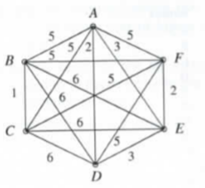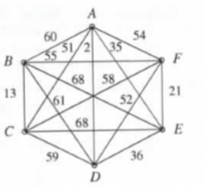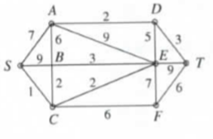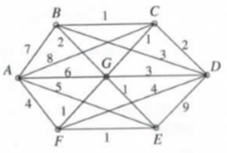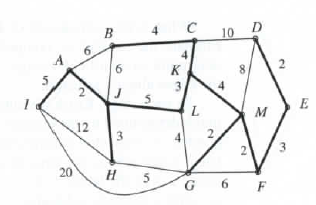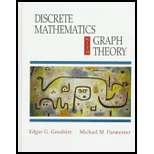
Discrete Mathematics with Graph Theory (Classic Version) (3rd Edition) (Pearson Modern Classics for Advanced Mathematics Series)
3rd Edition
ISBN: 9780134689555
Author: Edgar Goodaire, Michael Parmenter
Publisher: PEARSON
expand_more
expand_more
format_list_bulleted
Question
Chapter 12.3, Problem 4E
a)
To determine
The reason for Kruskal’s algorithm that could be modified so that it finds a spanning tree of maximum weight in a connected graph.
b)
To determine
A maximum spanning tree for each of the graphs and give the maximum weight of each by applying the modified algorithm described in (a).
Expert Solution & Answer
Want to see the full answer?
Check out a sample textbook solution
Students have asked these similar questions
5. The volume V of a given mass of
monoatomic gas changes with temperat re
T according to the relation
V = KT2/3. The work done when
temperature changes by 90 K will be xR.
The value of x is
(a) 60
(b)20
(c)30
S
(d)90
Consider a matrix
3
-2
1
A =
0
5 4
-6
2
-1
Define matrix B as transpose of the inverse of matrix A. Find the determinant of matrix A + B.
For each of the time series, construct a line chart of the data and identify the characteristics of the time series (that is, random, stationary, trend, seasonal, or cyclical).
Year Month Rate (%)2009 Mar 8.72009 Apr 9.02009 May 9.42009 Jun 9.52009 Jul 9.52009 Aug 9.62009 Sep 9.82009 Oct 10.02009 Nov 9.92009 Dec 9.92010 Jan 9.82010 Feb 9.82010 Mar 9.92010 Apr 9.92010 May 9.62010 Jun 9.42010 Jul 9.52010 Aug 9.52010 Sep 9.52010 Oct 9.52010 Nov 9.82010 Dec 9.32011 Jan 9.12011 Feb 9.02011 Mar 8.92011 Apr 9.02011 May 9.02011 Jun 9.12011 Jul 9.02011 Aug 9.02011 Sep 9.02011 Oct 8.92011 Nov 8.62011 Dec 8.52012 Jan 8.32012 Feb 8.32012 Mar 8.22012 Apr 8.12012 May 8.22012 Jun 8.22012 Jul 8.22012 Aug 8.12012 Sep 7.82012 Oct…
Chapter 12 Solutions
Discrete Mathematics with Graph Theory (Classic Version) (3rd Edition) (Pearson Modern Classics for Advanced Mathematics Series)
Ch. 12.1 - Prob. 1TFQCh. 12.1 - Prob. 2TFQCh. 12.1 - Prob. 3TFQCh. 12.1 - Prob. 4TFQCh. 12.1 - Prob. 5TFQCh. 12.1 - Prob. 6TFQCh. 12.1 - Prob. 7TFQCh. 12.1 - Prob. 8TFQCh. 12.1 - Prob. 9TFQCh. 12.1 - Prob. 10TFQ
Ch. 12.1 - Prob. 1ECh. 12.1 - Prob. 2ECh. 12.1 - Prob. 3ECh. 12.1 - Prob. 4ECh. 12.1 - Prob. 5ECh. 12.1 - Prob. 6ECh. 12.1 - Prob. 7ECh. 12.1 - Prob. 8ECh. 12.1 - 9. The vertices in the graph represent town; the...Ch. 12.1 - Prob. 11ECh. 12.1 - 12. [BB] suppose and are two paths from a vertex...Ch. 12.1 - Prob. 13ECh. 12.1 - Prob. 14ECh. 12.1 - Prob. 15ECh. 12.1 - Prob. 16ECh. 12.1 - 17. [BB] Recall that a graph is acyclic if it has...Ch. 12.1 - Prob. 18ECh. 12.1 - Prob. 19ECh. 12.1 - Prob. 20ECh. 12.1 - Prob. 21ECh. 12.1 - Prob. 22ECh. 12.1 - The answers to exercises marked [BB] can be found...Ch. 12.1 - Prob. 24ECh. 12.1 - Prob. 25ECh. 12.1 - A forest is a graph every component of which is a...Ch. 12.1 - Prob. 27ECh. 12.2 - Prob. 1TFQCh. 12.2 - Prob. 2TFQCh. 12.2 - Prob. 3TFQCh. 12.2 - Prob. 4TFQCh. 12.2 - Prob. 5TFQCh. 12.2 - Prob. 6TFQCh. 12.2 - Prob. 7TFQCh. 12.2 - Prob. 8TFQCh. 12.2 - Prob. 9TFQCh. 12.2 - Prob. 1ECh. 12.2 - Prob. 2ECh. 12.2 - Prob. 3ECh. 12.2 - Prob. 4ECh. 12.2 - Prob. 5ECh. 12.2 - Prob. 6ECh. 12.2 - Prob. 7ECh. 12.2 - Prob. 8ECh. 12.2 - Prob. 9ECh. 12.2 - Prob. 10ECh. 12.2 - Prob. 11ECh. 12.2 - Prob. 12ECh. 12.2 - Prob. 13ECh. 12.2 - Prob. 14ECh. 12.2 - Prob. 15ECh. 12.2 - Prob. 16ECh. 12.2 - Prob. 17ECh. 12.3 - If Kruskal’s algorithm is applied to after one...Ch. 12.3 - 2. If Kruskal’s algorithm is applied to we might...Ch. 12.3 - 3. If Kruskal’s algorithm is applied to we might...Ch. 12.3 - If Prim’s algorithm is applied to after one...Ch. 12.3 - If Prims algorithm is applied to we might end up...Ch. 12.3 - If Prims algorithm is applied to we might end up...Ch. 12.3 - Prob. 7TFQCh. 12.3 - Prob. 8TFQCh. 12.3 - Prob. 9TFQCh. 12.3 - Prob. 10TFQCh. 12.3 - Prob. 1ECh. 12.3 - Prob. 2ECh. 12.3 - Prob. 3ECh. 12.3 - Prob. 4ECh. 12.3 - The answers to exercises marked [BB] can be found...Ch. 12.3 - Prob. 6ECh. 12.3 - Prob. 7ECh. 12.3 - Prob. 8ECh. 12.3 - Prob. 9ECh. 12.3 - Prob. 10ECh. 12.3 - Prob. 11ECh. 12.3 - In our discussion of the complexity of Kruskals...Ch. 12.3 - Prob. 13ECh. 12.3 - Prob. 14ECh. 12.3 - Prob. 15ECh. 12.3 - Prob. 16ECh. 12.3 - Prob. 17ECh. 12.3 - Prob. 18ECh. 12.4 - The digraph pictured by is a cyclic.Ch. 12.4 - Prob. 2TFQCh. 12.4 - Prob. 3TFQCh. 12.4 - Prob. 4TFQCh. 12.4 - Prob. 5TFQCh. 12.4 - Prob. 6TFQCh. 12.4 - Prob. 7TFQCh. 12.4 - Prob. 8TFQCh. 12.4 - Prob. 9TFQCh. 12.4 - Prob. 10TFQCh. 12.4 - Prob. 1ECh. 12.4 - Prob. 2ECh. 12.4 - Prob. 3ECh. 12.4 - Prob. 4ECh. 12.4 - 5. The algorithm described in the proof of...Ch. 12.4 - How many shortest path algorithms can you name?...Ch. 12.4 - Prob. 7ECh. 12.4 - Prob. 8ECh. 12.4 - Prob. 10ECh. 12.4 - Prob. 11ECh. 12.4 - Prob. 12ECh. 12.4 - [BB] Explain how Bellmans algorithm can be...Ch. 12.4 - Prob. 14ECh. 12.5 - Prob. 1TFQCh. 12.5 - Depth-first search has assigned labels 1 and 2 as...Ch. 12.5 - Depth-first search has assigned labels 1 and 2 as...Ch. 12.5 - Prob. 4TFQCh. 12.5 - Prob. 5TFQCh. 12.5 - Prob. 6TFQCh. 12.5 - Prob. 7TFQCh. 12.5 - Prob. 8TFQCh. 12.5 - 9. Breadth-first search (see exercise 10) has...Ch. 12.5 - Prob. 10TFQCh. 12.5 - Prob. 1ECh. 12.5 - Prob. 2ECh. 12.5 - Prob. 3ECh. 12.5 - 4. (a) [BB] Let v be a vertex in a graph G that is...Ch. 12.5 - Prob. 5ECh. 12.5 - Prob. 6ECh. 12.5 - Prob. 7ECh. 12.5 - Prob. 8ECh. 12.5 - Prob. 9ECh. 12.5 - Prob. 10ECh. 12.5 - [BB; (a)] Apply a breath-first search to each of...Ch. 12.5 - Prob. 12ECh. 12.5 - Prob. 13ECh. 12.5 - Prob. 14ECh. 12.6 - Prob. 1TFQCh. 12.6 - Prob. 2TFQCh. 12.6 - Prob. 3TFQCh. 12.6 - Prob. 4TFQCh. 12.6 - Prob. 5TFQCh. 12.6 - Prob. 6TFQCh. 12.6 - Prob. 7TFQCh. 12.6 - Prob. 8TFQCh. 12.6 - Prob. 9TFQCh. 12.6 - Prob. 10TFQCh. 12.6 - Prob. 1ECh. 12.6 - Prob. 2ECh. 12.6 - Prob. 3ECh. 12.6 - Prob. 4ECh. 12.6 - Prob. 5ECh. 12.6 - Prob. 6ECh. 12.6 - Prob. 7ECh. 12.6 - Prob. 8ECh. 12.6 - Prob. 9ECh. 12.6 - Prob. 10ECh. 12.6 - Prob. 11ECh. 12.6 - Prob. 12ECh. 12.6 - Prob. 13ECh. 12.6 - Prob. 14ECh. 12.6 - Prob. 15ECh. 12 - Prob. 1RECh. 12 - Prob. 2RECh. 12 - Prob. 3RECh. 12 - Prob. 4RECh. 12 - 5. (a) Let G be a graph with the property that...Ch. 12 - Prob. 6RECh. 12 - Prob. 7RECh. 12 - Prob. 8RECh. 12 - Prob. 9RECh. 12 - Prob. 10RECh. 12 - Prob. 11RECh. 12 - Prob. 12RECh. 12 - Prob. 13RECh. 12 - Prob. 14RECh. 12 - Prob. 15RECh. 12 - Prob. 16RECh. 12 - Prob. 17RECh. 12 - Prob. 18RECh. 12 - In each of the following graphs, a depth-first...Ch. 12 - Prob. 20RECh. 12 - Prob. 21RECh. 12 - Prob. 22RECh. 12 - Prob. 23RECh. 12 - Prob. 24RECh. 12 - Prob. 25RECh. 12 - Prob. 26RE
Knowledge Booster
Similar questions
- For each of the time series, construct a line chart of the data and identify the characteristics of the time series (that is, random, stationary, trend, seasonal, or cyclical). Date IBM9/7/2010 $125.959/8/2010 $126.089/9/2010 $126.369/10/2010 $127.999/13/2010 $129.619/14/2010 $128.859/15/2010 $129.439/16/2010 $129.679/17/2010 $130.199/20/2010 $131.79 a. Construct a line chart of the closing stock prices data. Choose the correct chart below.arrow_forward1) Express these large and small numbers from the Read and Study section in scientific notation: (a) 239,000 miles (b) 3,800,000,000,000 sheets of paper (c) 0.0000000000000000000000167 grams 2) Find all values for the variable x that make these equations true. (a) 5x = 1 (b) 3x = 1/1 9 (c) 4* = 11/ 4 (e) 4* = 64 (g) 10x = 1,000,000 (d) 3x=-3 (f) 2x = = 8 (h) 10x = 0.001arrow_forward(b) 4) Find an equation to fit each of the following graphs: (a) 20 20 18 16 14 12 10 8 6 4 2 24 22 20 18 16 14 12 10 8 16 A 2 -3 -2 -1-0 2 3 4. -1 0 1 2 3. -2 -2arrow_forward
- 3) Which of the following are equivalent to 3? (There may be more than one that is equivalent!) -1 (a) (9)¯¹ 3. (b) (-3)-1 (c) (-3) -1 (d) -(¯3) (e) 11 3-1 (f) 3-4arrow_forwardY- ___b=_____ (X- )arrow_forwardFor each of the time series, construct a line chart of the data and identify the characteristics of the time series (that is, random, stationary, trend, seasonal, or cyclical) Date IBM9/7/2010 $125.959/8/2010 $126.089/9/2010 $126.369/10/2010 $127.999/13/2010 $129.619/14/2010 $128.859/15/2010 $129.439/16/2010 $129.679/17/2010 $130.199/20/2010 $131.79arrow_forward
- 5) State any theorems that you use in determining your solution. a) Suppose you are given a model with two explanatory variables such that: Yi = a +ẞ1x1 + ẞ2x2i + Ui, i = 1, 2, ... n Using partial differentiation derive expressions for the intercept and slope coefficients for the model above. [25 marks] b) A production function is specified as: Yi = α + B₁x1i + ẞ2x2i + Ui, i = 1, 2, ... n, u₁~N(0,σ²) where: y = log(output), x₁ = log(labor input), x2 = log(capital input) The results are as follows: x₁ = 10, x2 = 5, ỹ = 12, S11 = 12, S12= 8, S22 = 12, S₁y = 10, = 8, Syy = 10, S2y n = 23 (individual firms) i) Compute values for the intercept, the slope coefficients and σ². [20 marks] ii) Show that SE (B₁) = 0.102. [15 marks] iii) Test the hypotheses: ẞ1 = 1 and B2 = 0, separately at the 5% significance level. You may take without calculation that SE (a) = 0.78 and SE (B2) = 0.102 [20 marks] iv) Find a 95% confidence interval for the estimate ẞ2. [20 marks]arrow_forwardPage < 2 of 2 - ZOOM + The set of all 3 x 3 upper triangular matrices 6) Determine whether each of the following sets, together with the standard operations, is a vector space. If it is, then simply write 'Vector space'. You do not have to prove all ten vector space axioms. If it is not, then identify one of the ten vector space axioms with its number in the attached sheet that fails and also show that how it fails. a) The set of all polynomials of degree four or less. b) The set of all 2 x 2 singular matrices. c) The set {(x, y) : x ≥ 0, y is a real number}. d) C[0,1], the set of all continuous functions defined on the interval [0,1]. 7) Given u = (-2,1,1) and v = (4,2,0) are two vectors in R³-space. Find u xv and show that it is orthogonal to both u and v. 8) a) Find the equation of the least squares regression line for the data points below. (-2,0), (0,2), (2,2) b) Graph the points and the line that you found from a) on the same Cartesian coordinate plane.arrow_forward1. A consumer group claims that the mean annual consumption of cheddar cheese by a person in the United States is at most 10.3 pounds. A random sample of 100 people in the United States has a mean annual cheddar cheese consumption of 9.9 pounds. Assume the population standard deviation is 2.1 pounds. At a = 0.05, can you reject the claim? (Adapted from U.S. Department of Agriculture) State the hypotheses: Calculate the test statistic: Calculate the P-value: Conclusion (reject or fail to reject Ho): 2. The CEO of a manufacturing facility claims that the mean workday of the company's assembly line employees is less than 8.5 hours. A random sample of 25 of the company's assembly line employees has a mean workday of 8.2 hours. Assume the population standard deviation is 0.5 hour and the population is normally distributed. At a = 0.01, test the CEO's claim. State the hypotheses: Calculate the test statistic: Calculate the P-value: Conclusion (reject or fail to reject Ho): Statisticsarrow_forward
- Page < 1 of 2 - ZOOM + 1) a) Find a matrix P such that PT AP orthogonally diagonalizes the following matrix A. = [{² 1] A = b) Verify that PT AP gives the correct diagonal form. 2 01 -2 3 2) Given the following matrices A = -1 0 1] an and B = 0 1 -3 2 find the following matrices: a) (AB) b) (BA)T 3) Find the inverse of the following matrix A using Gauss-Jordan elimination or adjoint of the matrix and check the correctness of your answer (Hint: AA¯¹ = I). [1 1 1 A = 3 5 4 L3 6 5 4) Solve the following system of linear equations using any one of Cramer's Rule, Gaussian Elimination, Gauss-Jordan Elimination or Inverse Matrix methods and check the correctness of your answer. 4x-y-z=1 2x + 2y + 3z = 10 5x-2y-2z = -1 5) a) Describe the zero vector and the additive inverse of a vector in the vector space, M3,3. b) Determine if the following set S is a subspace of M3,3 with the standard operations. Show all appropriate supporting work.arrow_forwardFind the Laplace Transform of the function to express it in frequency domain form.arrow_forwardPlease draw a graph that represents the system of equations f(x) = x2 + 2x + 2 and g(x) = –x2 + 2x + 4?arrow_forward
arrow_back_ios
SEE MORE QUESTIONS
arrow_forward_ios
Recommended textbooks for you
 Linear Algebra: A Modern IntroductionAlgebraISBN:9781285463247Author:David PoolePublisher:Cengage Learning
Linear Algebra: A Modern IntroductionAlgebraISBN:9781285463247Author:David PoolePublisher:Cengage Learning

Linear Algebra: A Modern Introduction
Algebra
ISBN:9781285463247
Author:David Poole
Publisher:Cengage Learning
